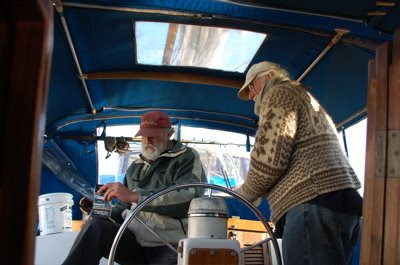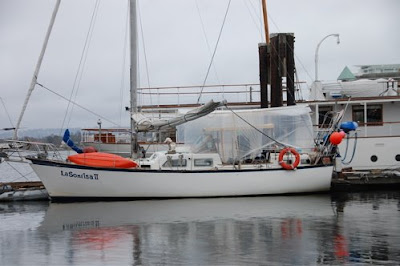
La Sonrisa celebrated Earth Day by sailing. We try to be as environmentally responsible as we can. Though we’re still using our old diesel, both our dinghy motor and generator are 4 stroke rather than 2 stroke. And as far as the diesel is concerned, we’ve lowered our average speed by 15% and achieved a 40% saving in fuel. We sail about half of the time. Every little bit helps. We often keep our sails up when others motor on by.

This Earth Day we began our trip south sailing down Trincomali Channel. By the time we got to Nose Point on Salt Spring Island the winds were very light. We found by draping the spinnaker sheet over the end of the boom, we were able to keep sailing slowly. It was a beautiful way to celebrate Earth Day.
 A seal watching us drift around Nose Point: “If you had a bum like mine you wouldn’t need a sail like yours!”
A seal watching us drift around Nose Point: “If you had a bum like mine you wouldn’t need a sail like yours!”Participating in a hunter-gatherer lifestyle is one way we live in keeping with our dream of sustainability and harmony with the earth. We celebrated Earth Day by gathering firewood, clams and oysters. We didn’t pick the newly sprouted oregano and lemon balm, leaving these gone-wild greens to grow a bit bigger.
The day before we had picked miner’s lettuce and maple flowers.

Here is good news about the western purple martins, the largest and chunkiest of the swallows.
These swallows once nested in cavities in old trees and snags. With the loss of their habitat and competition from introduced species, by 1985 their numbers had reached a low of 5 known breeding pairs. Nest boxes were introduced in various sites. These "man-made snags" were built in 1995 at Newcastle Island Provincial Park.

By 2006 at 45 colony sites numbers had increased to 600 nesting pairs of purple martins. They arrive here in April, nesting starts in May. The young martins fledge in late July and in mid August begin their migration to South America. Traditionally, South America native people encouraged their numbers, welcomed as insect eaters and an intruder alert. In turn, humans may offer some protection from predators.
When our Earth Day wind totally died and we finally got our anchor down, we were welcomed by another Earth Day neighbour, Annette the Otter.
 This otter seemed to be enjoying rolling in Canada goose droppings. She scrambled up rocks from the water's edge to the top of this vegetation covered rock mound.
This otter seemed to be enjoying rolling in Canada goose droppings. She scrambled up rocks from the water's edge to the top of this vegetation covered rock mound.
When we set out by dinghy to explore some tiny islets, the gulls were swooping above us in the wind currents. Just after we the tied the dinghy and took a few steps ashore, we had to rush back and launch it against heavy wind and waves. The gulls were telling us something – we hadn’t paid enough attention. We did manage to gather a quick handful of yarrow for tea, however. It was a wet ride back to La Sonrisa.









































